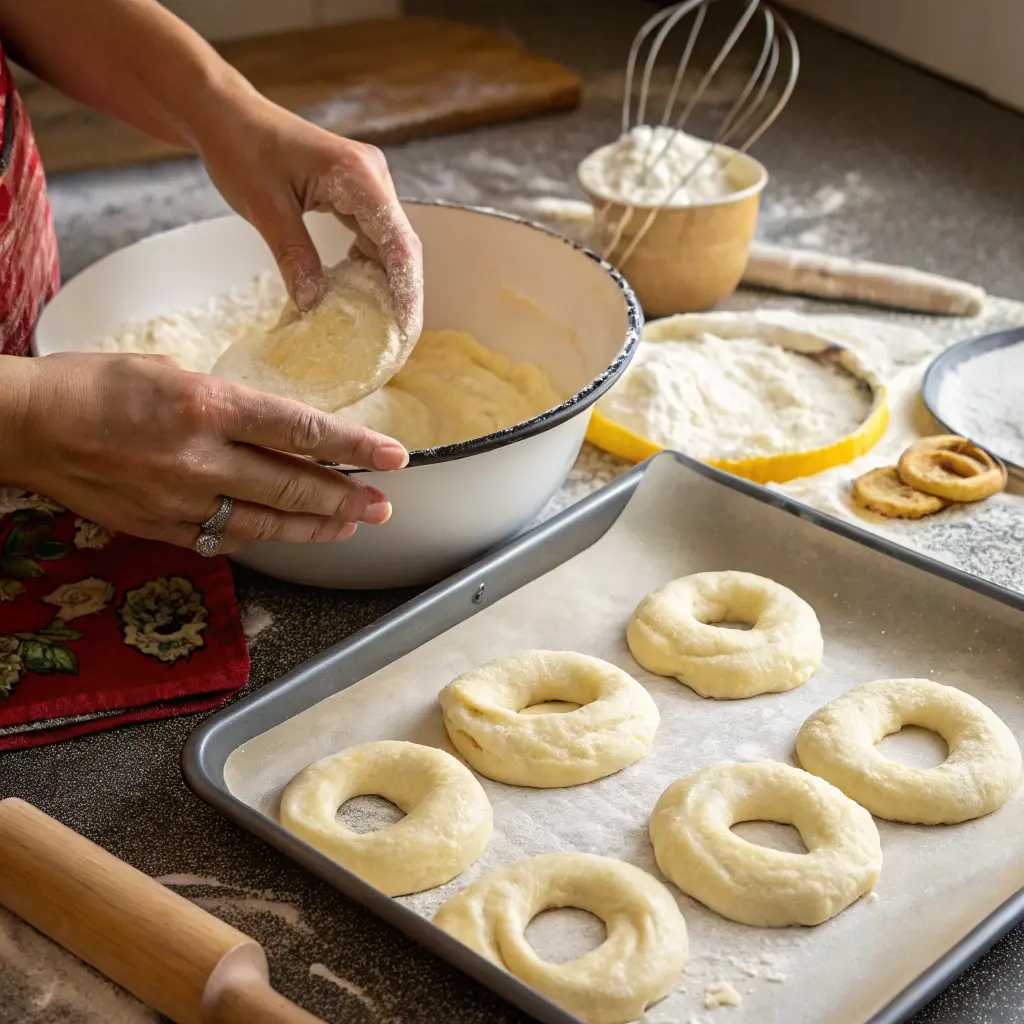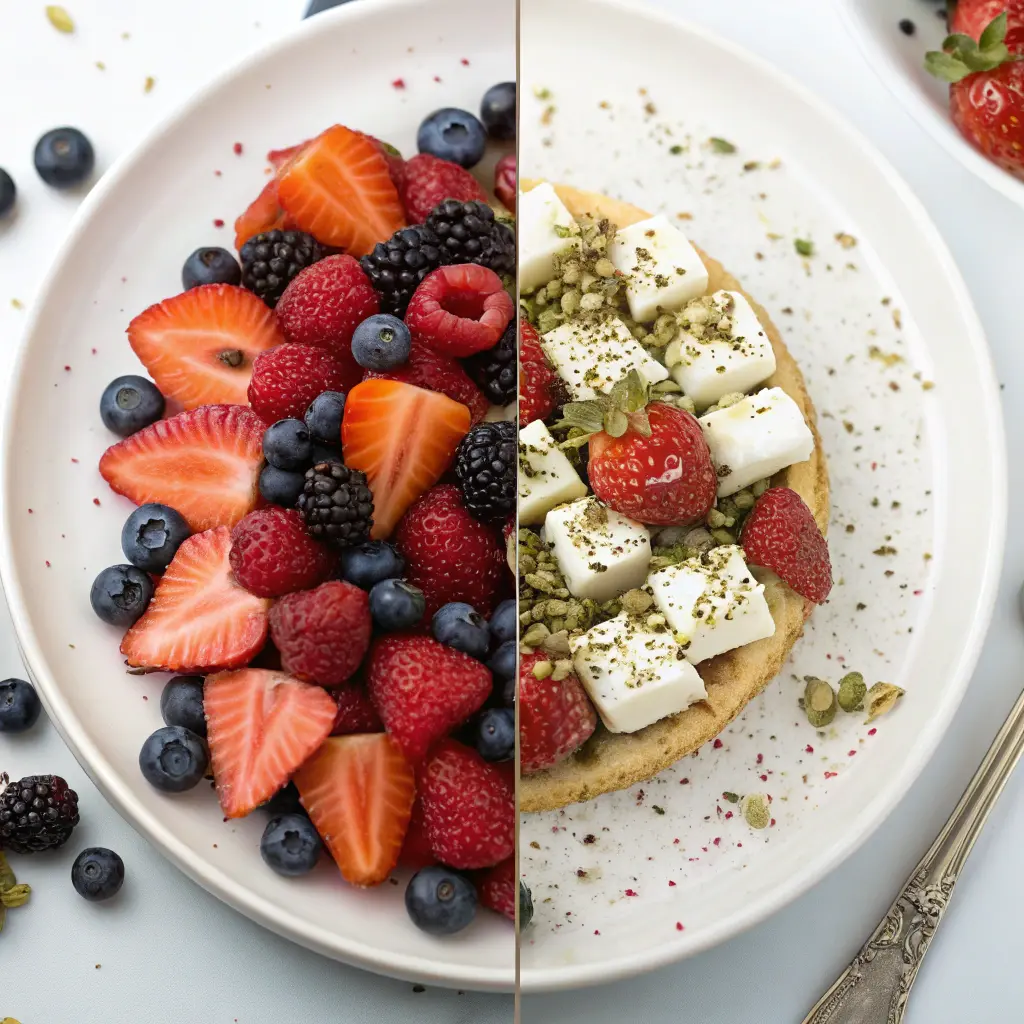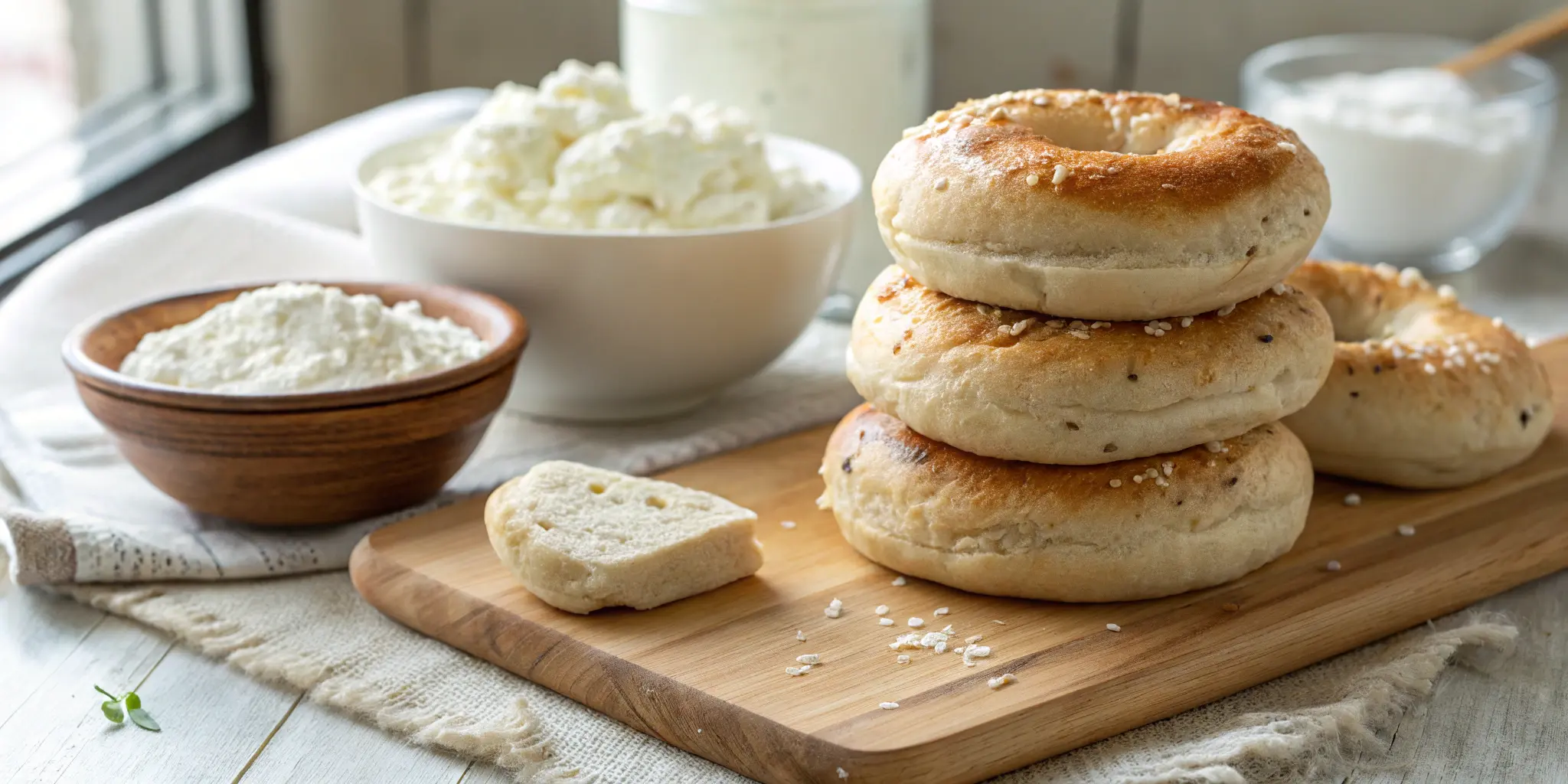Let’s be honest—most “healthy bagels” taste like cardboard. You know the type: dry, weirdly dense, and somehow always disappointing. But these High-Protein Cottage Cheese Bagels? They’re in a whole other league. I was skeptical too at first, mostly because cottage cheese in bread sounded like a sad diet trick. But after trying them once… I was hooked.
They’re chewy, they’re golden, they’re very easy to make, and they’ve got the kind of protein that actually keeps you full. And they don’t taste “healthy” in that dry, sawdust way. They taste like real-deal bagels—just with a little gym membership baked in.
This isn’t some trend from a wellness blog you forget in a week. These bagels are here to stay. I’m gonna show you how to make them, what makes them special, how to switch ‘em up, and yep—even how to store them for the week without turning them into hockey pucks.
So grab your mixing bowl and ditch the cream cheese guilt. Let’s talk High-Protein Cottage Cheese Bagels—the only bagel I’ll willingly eat after leg day.
What Exactly Are High-Protein Cottage Cheese Bagels?
Why High-Protein Cottage Cheese Bagels Are Trending:
You’ve probably seen these popping up on social media lately—TikTok, Instagram, even in gym meal prep circles. Everyone’s calling them “protein bagels,” but the real star is that secret ingredient: cottage cheese.
These aren’t just regular bagels with some protein powder thrown in. They’re made with a dough that starts with cottage cheese. That’s what gives them their moisture, their structure, and a surprising protein punch—without needing yeast or long proofing times. Yep, we’re skipping all that bakery science today.
The hype is real. They’re easy enough for beginners, quick enough for weekday mornings, and filling enough to stop you from snacking an hour later.
If you’re into high-protein recipes and smart kitchen swaps, you’d probably also love this cottage cheese air fryer baked potato skins recipe. Same logic: tasty meets fuel.
What Makes These Cottage Cheese Bagels So High in Protein
Here’s the thing—most standard bagels have about 9 grams of protein, give or take. These babies? We’re talking 15 to 20 grams per serving, depending on your mix-ins and the size.
That’s thanks to the combo of cottage cheese and high-protein flour like white whole wheat or oat flour. You can even sneak in some unflavored whey protein if you’re chasing those macros.
And unlike most store-bought “protein bagels” that are packed with fillers, these are made from simple, real ingredients. No weird preservatives. No unpronounceable nonsense.
Why Cottage Cheese Is the Secret to Protein-Packed Bagels
I know what you’re thinking. Cottage cheese? In bagels? Sounds like something your aunt who eats tofu ice cream might suggest.
But it’s not a gimmick. It actually gives the dough a creamy texture without needing added oil or butter. It also keeps the inside soft while the outside gets that perfect chew. Once baked, you don’t even taste the cottage cheese—just the flavor of a slightly tangy, satisfying bagel.
If you’re still on the fence, think of it like the way yogurt ends up in muffins—it’s there for structure and moisture, not taste. And honestly, the texture win is worth it.
If you’re interested in playing with flavor, this is the same idea behind this matcha brownies recipe—unexpected ingredients that just work.
Key Benefits of Eating High-Protein Cottage Cheese Bagels Every Day
Perfect for Meal Prep or Busy Mornings
Let’s face it, mornings can be chaos. Whether you’re running late, packing lunches, or trying to remember where you put your keys, breakfast sometimes doesn’t happen. That’s where these bagels come in.
Bake a batch on Sunday, and you’re set for the week. They store well, they reheat easily, and they’re way better than store-bought protein bars or those frozen “healthy” breakfast sandwiches that taste like rubber.
And since each one packs in protein, you won’t be starving by 10 a.m. I’ve even tossed one in my bag and eaten it cold at the gym parking lot—still good. Not glamorous, but it got the job done.
Kind of like how this rotisserie chicken for the week guide helps you prep smarter, these bagels are a meal-prepper’s secret weapon.
Great for Fitness Goals and Appetite Control
Protein does more than build muscle. It helps with satiety—basically, it keeps you full longer. That’s why these bagels hit different compared to regular ones. You don’t eat one and immediately start craving something else.
They’re especially helpful if you’re trying to eat higher protein without cooking a million eggs. Add a smear of nut butter or slice of turkey, and you’ve got a balanced meal that won’t spike your blood sugar or leave you crashing before lunch.
And no, they’re not just for people tracking macros or cutting carbs. They’re for anyone who wants a bagel that won’t ghost you an hour later.
Lower in Carbs, Higher in Satiety
Let’s clear this up: these aren’t keto bagels. They’ve got some carbs—but that’s a good thing. You need carbs for energy. The difference is, these bagels give you the right kind of carbs, balanced with solid protein and not a bunch of empty fluff.
Most bagels are all flour, no filler. These are flour plus protein, which means you’re getting something more nutritionally balanced. That makes them perfect for folks who want to enjoy bread without that post-carb crash.
The texture is also better than most “low-carb” options, which tend to be dry or oddly spongy. These are chewy, soft in the middle, and golden on the outside.
Main Ingredients That Make These Bagels High-Protein
How Cottage Cheese Boosts Protein in Bagel Dough
So here’s the deal: not all cottage cheese is created equal. Some are chunky, some are smooth, and some are just…weird. For these bagels, you want one that’s blended or smooth-style, or at least one you can pulse in a blender before mixing it in.
Why? Because smoother cottage cheese mixes better into the dough and helps everything hold together without leaving random pockets of mush. It also keeps the inside moist and adds a subtle tang that balances perfectly with savory toppings like garlic, everything seasoning, or even a hint of cheddar.
And if you’re thinking, “Can I use low-fat?”—sure, but don’t go non-fat unless you really have to. The fat gives it a richer texture and better flavor. Kind of like how you wouldn’t make sweet potato pie without a touch of butter—it just wouldn’t hit the same.
Best Flour Types for High-Protein Bagel Recipes
Most people go straight for all-purpose flour, and you can use that here, but if you want the best of both worlds—chew and nutrition—reach for white whole wheat flour or oat flour.
White whole wheat has a lighter texture than regular whole wheat, but still brings a nice protein boost and more fiber. Oat flour gives a softer feel and plays well with cottage cheese, but it’s a bit more delicate. I’ve done a 50/50 split before, and it worked great.
If you’re really chasing protein macros, you can even sneak in a tablespoon or two of unflavored whey protein or vital wheat gluten—just not too much or you’ll end up with dense, chewy little bricks. Trust me, I’ve done that too.
Extra Mix-Ins That Make High-Protein Cottage Cheese Bagels Even Better (Optional)
Wanna take it to the next level? Try one of these mix-ins:
- Grated Parmesan or cheddar (adds flavor + a few grams of protein)
- Chopped turkey bacon or real bacon bits
- Ground flax or chia seeds (adds healthy fats and fiber, too)
- Unflavored protein powder (start with 1 tbsp per batch)
You can even sprinkle a bit of cheese or hemp seeds on top before baking to make them look extra bakery-style. No one needs to know it’s your healthy version.
Just remember: keep the add-ins balanced. You want that signature chewy bagel bite, not a protein-loaded brick that feels like gym food. We’re making breakfast, not punishment.
Step-by-Step Guide to Making High-Protein Cottage Cheese Bagels

Ingredients List (Simple and Affordable)
Here’s everything you need—no weird ingredients, no protein powder required (unless you want to toss it in).
Basic Dough:
- 1 cup cottage cheese (blended if chunky)
- 1 cup white whole wheat flour (or a 50/50 mix with oat flour)
- 1 teaspoon baking powder
- 1/2 teaspoon salt
- 1 large egg (for the dough)
- Optional: 1 tablespoon unflavored protein powder
Topping:
- 1 egg (beaten, for egg wash)
- Optional: Everything seasoning, sesame seeds, shredded cheese, etc.
That’s it. Nothing fancy. You probably already have most of this in your kitchen. And if not? Quick grocery run, five bucks tops.
Mixing and Shaping Tips That Make a Difference
1. Prep the cottage cheese:
If your cottage cheese is chunky, toss it in a blender or food processor until smooth. You want that creamy texture so it blends right into the dough without clumps.
2. Mix the dry ingredients:
In a bowl, stir together your flour, baking powder, and salt. If you’re adding protein powder, toss it in here too. Mixing it dry first helps it blend more evenly.
3. Add the wet stuff:
Add in the egg and your blended cottage cheese. Stir it with a spoon until it forms a dough. It’ll be a little sticky—don’t panic. That’s normal.
4. Knead lightly:
Flour your hands and knead the dough just a few times in the bowl or on a lightly floured surface. Don’t overdo it. We’re not making sourdough here.
5. Divide and shape:
Split the dough into 4 to 6 even pieces (depending on how big you want your bagels). Roll each piece into a log and connect the ends to form a ring. You can also just roll them into balls and poke a hole through the center with your thumb—your call.
6. Add toppings:
Place them on a parchment-lined baking sheet. Brush with the beaten egg and sprinkle on your toppings. Go wild or keep it simple.
Baking Instructions for That Golden Crust
1. Bake at 375°F for 25–28 minutes.
Keep an eye on them around the 22-minute mark. You want golden tops and a firm outer crust.
2. Cool before slicing.
Let them rest for at least 10 minutes. If you slice too early, they’ll be a bit too soft in the center. Letting them cool helps the inside set.
And there you have it—real-deal High-Protein Cottage Cheese Bagels, made at home, in under an hour, start to finish. They’re chewy, satisfying, and way better than anything labeled “keto-friendly” at the store.
This kind of easy home recipe reminds me of how much better things taste when you skip the shortcuts—same vibe you get with homemade sourdough bagels versus the store-bought ones that go stale in a day.
Mistakes That Can Ruin Your Cottage Cheese Bagel Recipe
Using the Wrong Cottage Cheese Texture
First things first: texture matters. A lot.
If you toss chunky cottage cheese straight into your dough, you’re gonna end up with weird clumps that don’t mix well, bake unevenly, and leave funky wet spots in the bagel. Not great.
Fix: Use smooth cottage cheese or blend it before adding it to your mix. A quick pulse in a blender or food processor gives you the creamy base this dough needs. No blender? A few minutes with a fork and some patience will do in a pinch.
How to Avoid Overmixing and Undercooking Protein Bagels
This is where things can get tricky.
Overmixing the dough can lead to bagels that are tough and dense, kind of like eating rubber rings. Not fun. The proteins in the flour start developing too much gluten when you work the dough like a bread recipe—and that’s not what we want here.
Undermixing, on the other hand, leaves you with a sloppy dough that doesn’t hold shape. It spreads too much while baking and loses that bagel feel.
Fix: Mix just until the dough comes together, then knead gently 4–5 times. That’s all you need.
Then there’s underbaking—a mistake I made when I was in a rush. They looked golden on the outside but were still wet and doughy inside.
Fix: Always check for doneness by gently pressing the top. It should spring back slightly and feel firm—not squishy. Bake a little longer if needed. Every oven’s different.
Not Letting the Dough Rest Enough
I know the recipe moves fast, but even 5–10 minutes of rest before baking helps the dough relax. Without that pause, the bagels can bake up uneven or split weirdly.
It’s kinda like letting cornbread sit before baking—small step, big difference. If you’ve ever tried this Jiffy cornbread dressing recipe, you’ll know what I mean. Same idea: rest helps texture settle.
Fix: Once your bagels are shaped, give them 10 minutes to chill on the pan before they go into the oven. Let the baking powder do its thing and the dough firm up slightly.
Creative Twists on High-Protein Cottage Cheese Bagels

Sweet Bagels with Protein and Fruit Mix-Ins
Yep, sweet bagels are totally a thing—and they work really well with cottage cheese dough. It’s kind of like a protein-packed muffin in bagel form.
Try these add-ins:
- Blueberries or chopped dried fruit (cranberries, raisins)
- Dash of cinnamon + vanilla
- A swirl of almond butter or peanut butter inside the dough
- Mini chocolate chips (because why not?)
Pair one of these with a little Greek yogurt and berries, and you’ve got a killer breakfast that tastes like dessert but fuels you for hours.
Savory Versions (Everything Seasoning, Garlic, Herb)
This is my personal favorite. Think bagel shop vibes but homemade and macro-friendly.
Try these toppings or mix-ins:
- Everything but the bagel seasoning
- Fresh chopped chives or scallions
- Garlic powder + shredded cheddar
- Jalapeño slices + cream cheese spread (after baking)
Savory bagels are great for breakfast sandwiches or even as a base for mini pizzas. Just slice, toast, and top with sauce and cheese.
This kind of savory remix reminds me of creative ideas like this creamy cucumber salad—simple, flexible, and always satisfying.
Gluten-Free or Low-Carb Versions
If you’re gluten-sensitive, try using a gluten-free flour blend that includes xanthan gum (for structure). Almond flour can also work, but the texture will be softer and more biscuit-like.
For low-carb folks, you can sub in coconut flour or almond flour with a little extra egg and baking powder—but keep in mind, it changes the game completely. Expect more of a dense, mini loaf texture.
If you’re going low-carb and want a little inspiration for balanced meals, you might like this healthy deviled eggs without mayo recipe—simple swaps, big payoff.
How Much Protein Is Actually in These Bagels?
Protein Comparison with Regular Bagels
Let’s break it down real quick.
- Regular store-bought bagel (plain): ~9g protein
- These cottage cheese bagels: ~15–20g protein (depending on your mix-ins)
That’s more than double the protein in the same serving size, with fewer ingredients and better macros. If you add turkey, egg, or smoked salmon, you’re easily building a 30g+ protein meal. Not bad for a homemade snack, right?
Tracking Macros Made Easy
To keep things flexible, you can weigh your dough before baking and divide by the number of bagels to get exact macros per serving. If you’re logging food into apps like MyFitnessPal, just enter the ingredients as a custom recipe—super simple.
Storage Tips: Keeping Them Fresh for the Week
Fridge Storage Do’s and Don’ts
Once they’ve cooled, store your bagels in an airtight container in the fridge for up to 5 days. I like wrapping each one in parchment paper to keep the texture nice.
Don’t: Store them hot. They’ll steam and get soggy.
Do: Let them cool completely on a wire rack before refrigerating.
Can You Freeze High-Protein Bagels? Yes, Here’s How
Yes, and they freeze like a dream.
Here’s how:
- Let bagels cool completely.
- Wrap individually in plastic wrap or parchment.
- Place all in a freezer bag or airtight container.
When you’re ready to eat, defrost at room temp or pop into the toaster oven. They come back to life better than most frozen baked goods—no weird texture shifts.
This method works a lot like prepping ahead with freezer-friendly chicken casseroles. Just smarter planning.
What to Eat With High-Protein Cottage Cheese Bagels
Easy Pairings for a Full Meal
- Sliced turkey + tomato + avocado = protein bomb
- Almond butter + banana slices = sweet and salty fuel
- Scrambled eggs + cheese + spinach = morning win
- Cottage cheese + berries on top (double cottage, I know… but it slaps)
Breakfast Sandwich Ideas or Post-Workout Fuel
Want a bagel sandwich that feels like a brunch café order?
Try this:
- Toasted bagel
- 1 fried egg
- 2 slices turkey bacon
- Handful of arugula
- Dash of hot sauce
Or go full post-workout with:
- Bagel + grilled chicken breast + hummus spread
- Bagel + cottage cheese + sliced cucumbers and cracked pepper
You’re getting protein, carbs, and flavor without feeling like you just ate a brick.
Print
High-Protein Cottage Cheese Bagels That Actually Taste Amazing
- Total Time: 35 minutes
- Yield: 4 bagels 1x
Description
These high-protein cottage cheese bagels are chewy, flavorful, and packed with protein—perfect for a healthy breakfast or snack!
Ingredients
- 1 cup cottage cheese
- 1 cup all-purpose flour
- 2 tsp baking powder
- 1/2 tsp salt
- 1 egg (for egg wash)
- Everything bagel seasoning (optional)
Instructions
- Preheat oven to 375°F (190°C) and line a baking sheet with parchment paper.
- Blend cottage cheese until smooth if desired.
- In a bowl, mix cottage cheese, flour, baking powder, and salt until a dough forms.
- Divide dough into 4 portions and shape into bagels.
- Place bagels on prepared baking sheet.
- Brush tops with egg wash and sprinkle with seasoning if using.
- Bake for 25–30 minutes until golden brown and cooked through.
- Let cool slightly before serving.
Notes
Use full-fat or low-fat cottage cheese depending on your preference. Blending the cottage cheese results in a smoother dough. Customize toppings to taste.
- Prep Time: 10 minutes
- Cook Time: 25 minutes
- Category: Breakfast
- Method: Baking
- Cuisine: American
Nutrition
- Serving Size: 1 bagel
- Calories: 180
- Sugar: 1g
- Sodium: 320mg
- Fat: 4g
- Saturated Fat: 2g
- Unsaturated Fat: 1g
- Trans Fat: 0g
- Carbohydrates: 22g
- Fiber: 1g
- Protein: 12g
- Cholesterol: 35mg
Conclusion
If you’re looking for a high-protein recipe that doesn’t feel like a chore to eat, these High-Protein Cottage Cheese Bagels are it. They’re simple, filling, and flexible enough to fit just about any kind of eater—from gym folks to busy parents to anyone who just wants to eat better without overthinking it.
One batch, a handful of ingredients, and boom—you’ve got a week’s worth of grab-and-go meals that actually taste good. No rubbery protein bars. No sad breakfasts. Just good, homemade fuel that hits the spot.
FAQs: Answers to Your High-Protein Cottage Cheese Bagels Questions
How much protein is in a cottage cheese bagel?
On average, one homemade high-protein cottage cheese bagel has around 15 to 20 grams of protein, depending on the ingredients you use and if you add extras like seeds or cheese.
Which bagels have the highest protein?
The highest protein bagels are usually homemade ones made with cottage cheese, Greek yogurt, or added whey protein. Store-bought “protein bagels” tend to have 10–12 grams, but homemade versions can go up to 20 grams or more.
What to put on bagels for high protein?
Top your bagel with things like turkey slices, smoked salmon, scrambled eggs, cottage cheese, Greek yogurt, or almond butter. You can also add protein-rich spreads like hummus or low-fat cream cheese blended with whey.
Is cottage cheese a good high-protein food?
Yes, it’s one of the best. One cup of cottage cheese has about 25 grams of protein, making it a great option for meals or baking recipes where you want to sneak in more protein.
Which is healthier: 2% or 4% cottage cheese?
Both are good, but 2% has less fat and fewer calories, while 4% is creamier and more satisfying. If you’re tracking macros, 2% is great. If you want more flavor and richness, go for 4%.
How much protein is in 2 eggs and cottage cheese?
Two eggs give you about 12 grams of protein. Add 1/2 cup of cottage cheese (about 13g protein), and you’re looking at a solid 25 grams total—perfect for breakfast or post-workout fuel.
What is the most high-protein breakfast?
A combo of eggs, cottage cheese, and a high-protein bagel hits all the marks—30–40g of protein easy. Add a side of turkey bacon or a protein smoothie, and you’re golden.

